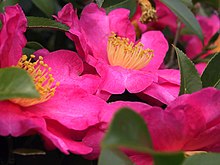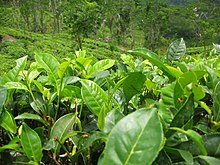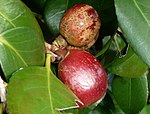Camellia
| Camellia | |
|---|---|

| |
| Camellia sasanquais used as a garden plant, its leaves are used for tea, and its seeds for oil | |
| Scientific classification | |
| Kingdom: | Plantae |
| Clade: | Tracheophytes |
| Clade: | Angiosperms |
| Clade: | Eudicots |
| Clade: | Asterids |
| Order: | Ericales |
| Family: | Theaceae |
| Genus: | Camellia L. |
| Species | |
|
About 187, seetext | |
| Synonyms[1] | |
| |
Camellia(pronounced/kəˈmɛliə/[2]or/kəˈmiːliə/[3]) is agenusof flowering plants in the familyTheaceae.[1]They are found in tropical and subtropical areas ineasternandsouthern Asia,from theHimalayaseast toJapanandIndonesia.There are more than 220 describedspecies.[1]Camellias are popular ornamental, tea and woody-oil plants that have been cultivated throughout the world for centuries. To date, over 26,000 cultivars, with more than 51,000 cultivar names including synonyms, have been registered or published.[4][5]
Of economic importance in East Asia, Southeast Asia, and the Indian subcontinent, leaves ofC. sinensisare processed to create the popular beveragetea.The ornamentalC. japonica,C. sasanquaand theirhybridsare the source of hundreds of gardencultivars.C. oleiferaproducestea seed oil,used in cooking and cosmetics.
Taxonomy
[edit]The genus was named byLinnaeusafter the Jesuit botanistGeorg Joseph Kamel,who worked in the Philippines and described one of its species (although Linnaeus did not refer to Kamel's account when discussing the genus).[6]: 246, 255
Botany
[edit]
Camellias areevergreenshrubsor smalltreesup to 20 m (66 ft) tall. Their leaves are alternately arranged, simple, thick, serrated, and usually glossy.
Flowers and fruit
[edit]Their flowers are usually large and conspicuous, one to 12 cm in diameter, with five to nine petals in naturally occurring species of camellias. The colors of the flowers vary from white through pink colors to red; truly yellow flowers are found only in South China and Vietnam. Tea varieties are always white-flowered. Camellia flowers throughout the genus are characterized by a dense bouquet of conspicuous yellow stamens, often contrasting with the petal colors.[7][page needed][8]Some research has shown that the colour of petals in some species' flowers indicate their size and how they arepollinated;species with red or yellow flowers are pollinated bysunbirdswhereas species with white flowers are smaller in diameter and are pollinated by bees.[9]: 3–4
Thefruitof camellia plants is a drycapsule,sometimes subdivided in up to five compartments, each compartment containing up to eightseeds.
Growth
[edit]The various species of camellia plants are generally well-adapted toacid soilsrich inhumus,and most species do not grow well onchalkysoil or othercalcium-rich soils. Most species of camellias also require a large amount of water, either from natural rainfall or fromirrigation,and the plants will not toleratedroughts.However, some of the more unusual camellias – typically species fromkarstsoils inVietnam– can grow without too much water.
Camellia plants usually have a rapid growth rate. Typically they will grow about 30 cm per year until mature – though this does vary depending on their variety and geographical location.
Ecology
[edit]Camellia plants are used as food plants by thelarvaeof a number ofLepidopteraspecies. Leaves ofCamellia japonicaare susceptible to thefungalparasiteMycelia sterile(seebelowfor the significance),mycelia sterile PF1022produces ametabolitenamed PF1022A that is used to produceemodepside,ananthelminticdrug.[10]
Mainly due tohabitat destruction,several camellias have become quite rare in their natural range. One of these is the aforementionedC. reticulata,grown commercially in thousands for horticulture and oil production, but rare enough in its natural range to be considered athreatened species.
Use by humans
[edit]
Camellia sinensis,the tea plant, is of major commercial importance becauseteais made from its leaves. The speciesC. sinensisis the product of many generations ofselective breedingin order to bring out qualities considered desirable for tea. However, many other camellias can be used to produce a similar beverage. For example, in some parts of Japan, tea made fromC. sasanqualeaves is popular.
Seeds ofC. oleifera,C. japonica,and to a lesser extent other species such asC. crapnelliana,C. reticulata,C. sasanquaandC. sinensisas well are pressed to maketea seed oil,a sweet seasoning and cooking oil special to East Asia. It is the most importantcooking oilfor hundreds of millions of people, particularly in southern China.
Camellia oil is commonly used to clean and protect the blades of cutting instruments.
Camellia oil pressed from seeds ofC. japonica,also called tsubaki oil or tsubaki-abura ( xuân du ) in Japanese, has been traditionally used in Japan for hair care.[11]C. japonicaplant is used to prepare traditional antiinflammatory medicines.[12]
History
[edit]Fossil record
[edit]The earliestfossilrecord ofCamelliaare the leaves of †C. abensisfrom the upperEocene ofJapan,†C. abchasicafrom the lowerOligoceneofBulgariaand †C. multiformafrom the lowerOligoceneofWashington,United States.[13]
Garden history
[edit]Camellias were cultivated in the gardens of China for centuries before they were seen in Europe. The German botanistEngelbert Kaempferreported[14]that the "Japan Rose", as he called it, grew wild in woodland and hedgerow, but that many superior varieties had been selected for gardens. Europeans' earliest views of camellias must have been their representations in Chinese painted wallpapers, where they were often represented growing in porcelain pots.
The first living camellias seen in England were a single red and a single white, grown and flowered in his garden atThorndon Hall,Essex, byRobert James, Lord Petre,among the keenest gardeners of his generation, in 1739. His gardenerJames Gordonwas the first to introduce camellias to commerce, from the nurseries he established after Lord Petre's untimely death in 1743, at Mile End, Essex, near London.[15]
With the expansion of thetea tradein the later 18th century, new varieties began to be seen in England, imported through theBritish East India Company.The Company's John Slater was responsible for the first of the new camellias, double ones, in white and a striped red, imported in 1792. Further camellias imported in the East Indiamen were associated with the patrons whose gardeners grew them: a double red for Sir Robert Preston in 1794 and the pale pink named "Lady Hume's Blush" for Amelia, the lady ofSir Abraham HumeofWormleybury,Hertfordshire (1806). The camellia was imported from England to America in 1797 whenColonel John Stevensbrought the flower as part of an effort to grow attractions withinElysian FieldsinHoboken,New Jersey.[16]By 1819, twenty-five camellias had bloomed in England; that year the first monograph appeared, Samuel Curtis's,A Monograph on the Genus Camellia,whose five handsome folio colored illustrations have usually been removed from the slender text and framed. Camellias that set seed, though they did not flower for more than a decade, rewarded their growers with a wealth of new varieties. By the 1840s, the camellia was at the height of its fashion astheluxury flower. The Parisian courtesanMarie Duplessis,who died young in 1847, inspired Dumas'La Dame aux caméliasand Verdi'sLa Traviata.
The fashionable imbricated formality of prized camellias was an element in their decline, replaced by the new hothouseorchid.Their revival after World War I as woodland shrubs for mild climates has been paralleled by the rise in popularity ofCamellia sasanqua.
Modern cultivars
[edit]The tea camellia,C. sinensis,hasmany commercial cultivarsselected for the taste of their leaves once processed into tea leaves.
Today camellias are grown as ornamental plants for their flowers; about 3,000cultivarsandhybridshave been selected, many withdoubleor semi-double flowers.C. japonicais the most prominent species in cultivation, with over 2,000 named cultivars. Next areC. reticulatawith over 400 named cultivars, andC. sasanquawith over 300 named cultivars. Popular hybrids includeC. × hiemalis(C. japonica×C. sasanqua) andC. × williamsii(C. japonica×C. saluenensis). Some varieties can grow to a considerable size, up to100m2,though more compact cultivars are available. They are frequently planted in woodland settings, alongside othercalcifugessuch asrhododendrons,and are particularly associated with areas of high soil acidity, such as Cornwall and Devon in the UK. They are highly valued for their very early flowering, often among the first flowers to appear in the late winter. Latefrostscan damage the flower buds, resulting in misshapen flowers.[17]
There is great variety of flower forms:
- single (flat, bowl- or cup-shaped)
- semi-double (rows of large outer petals, with the centre comprising mixed petals and stamens)
- double:
- paeony form (convex mass of irregular petals and petaloids with hidden stamens)
- anemone form (one or more rows of outer petals, with mixed petaloids and stamens in the centre)
- rose form (overlapping petals showing stamens in a concave centre when open)
- formal double (rows of overlapping petals with hidden stamens)
AGM cultivars
[edit]The following hybrid cultivars have gained theRoyal Horticultural Society'sAward of Garden Merit:
| Name | Parentage | Height | Spread | Flower colour | Flower type | Ref. |
|---|---|---|---|---|---|---|
| Cornish Snow | cuspidata×saluenensis | 2.5 | 1.5 | white | single | [18] |
| Cornish Spring | cuspidata×japonica | 2.5 | 1.5 | pink | single | [19] |
| Francie L | 8.0 | 8.0 | rose-pink | double | [20] | |
| Freedom Bell | ×williamsii | 2.5 | 2.5 | red | semi-double | [21] |
| Inspiration | reticulata×saluenensis | 4.0 | 2.5 | rose-pink | semi-double | [22] |
| Leonard Messel | reticulata× ×williamsii | 4.0 | 4.0 | rose-pink | semi-double | [23] |
| Royalty | japonica×reticulata | 1.0 | 1.0 | light red | semi-double | [24] |
| Spring Festival | ×williamsii,cuspidata | 4.0 | 2.5 | pink | semi-double | [25] |
| Tom Knudsen | japonica×reticulata | 2.5 | 2.5 | deep red | double paeony | [26] |
| Tristrem Carlyon | reticulata | 4.0 | 2.5 | rose pink | double paeony | [27] |
-
Simple-floweredCamellia × williamsiicv. 'Brigadoon'
-
Semi-double-flowered camellia cultivar
-
Double-flowered camellia cultivar
-
Double-flowered hybrid cv. 'Jury's Yellow'
Species
[edit]






Plants of the World Onlinecurrently includes:[1]
- Camellia albataOrel & Curry
- Camellia amplexicaulis(Pit.) Cohen-Stuart
- Camellia amplexifoliaMerr. & Chun
- Camellia anlungensisHung T.Chang
- Camellia assimiloidesSealy
- Camellia aureaHung T.Chang
- Camellia azaleaC.F.Wei
- Camellia brevistyla(Hayata) Cohen-Stuart
- Camellia bugiamapensisOrel, Curry, Luu & Q.D.Nguyen
- Camellia campanulataOrel, Curry & Luu
- Camellia candidaHung T.Chang
- Camellia capitataOrel, Curry & Luu
- Camellia cattienensisOrel
- Camellia caudataWall.
- Camellia chekiangoleosaHu
- Camellia cherryanaOrel
- Camellia chinmeiaeS.L.Lee & T.Y.A.Yang
- Camellia chrysanthoidesHung T.Chang
- Camellia concinnaOrel & Curry
- Camellia connata(Craib) Craib
- Camellia corallina(Gagnep.) Sealy
- Camellia cordifolia(F.P.Metcalf) Nakai
- Camellia costataS.Y.Hu & S.Y.Liang
- Camellia costeiH.Lév.
- Camellia crapnellianaTutcher– Crapnell's camellia
- Camellia crassicolumnaHung T.Chang
- Camellia crassipesSealy
- Camellia crassiphyllaNinh & Hakoda
- Camellia cuongianaOrel & Curry
- Camellia cupiformisT.L.Ming
- Camellia curryanaOrel & Luu
- Camellia cuspidata(Kochs) Bean
- Camellia dalatensisV.D.Luong, Ninh & Hakoda
- Camellia debaoensisR.C.Hu & Y.Q.Liufu
- Camellia decoraOrel, Curry & Luu
- Camellia dilinhensisNinh & V.D.Luong
- Camellia dongnaicensisOrel
- Camellia dormoyana(Pierre ex Laness.) Sealy
- Camellia drupiferaLour.
- Camellia duyanaOrel, Curry & Luu
- Camellia edithaeHance
- Camellia elizabethaeOrel & Curry
- Camellia elongata(Rehder & E.H.Wilson) Rehder
- Camellia erubescensOrel & Curry
- Camellia euphlebiaMerr. ex Sealy
- Camellia euryoidesLindl.
- Camellia fangchengensisS.Ye Liang & Y.C.Zhong
- Camellia fansipanensisJ.M.H.Shaw, Wynn-Jones & V.D.Nguyen
- Camellia fascicularisHung T.Chang
- Camellia flava(Pit.) Sealy
- Camellia flavidaHung T.Chang
- Camellia fleuryi(A.Chev.) Sealy
- Camellia fluviatilisHand.-Mazz.
- Camellia forrestii(Diels) Cohen-Stuart
- Camellia fraternaHance
- Camellia furfuracea(Merr.) Cohen-Stuart
- Camellia gaudichaudii(Gagnep.) Sealy
- Camellia gilbertii(A.Chev.) Sealy
- Camellia glabricostataT.L.Ming
- Camellia gracilipesMerr. ex Sealy
- Camellia grandibracteataHung T.Chang, Y.J.Tan, F.L.Yu & P.S.Wang
- Camellia granthamianaSealy– Grantham's camellia
- Camellia grijsiiHance
- Camellia gymnogynaHung T.Chang
- Camellia harlandiiOrel & Curry
- Camellia hatinhensisV.D.Luong, Ninh & L.T.Nguyen
- Camellia hekouensisC.J.Wang & G.S.Fan
- Camellia hiemalisNakai
- Camellia honbaensisLuu, Q.D.Nguyen & G.Tran
- Camellia hongiaoensisOrel & Curry
- Camellia hongkongensisSeem.
- Camellia hsinpeiensisS.S.Ying
- Camellia huanaT.L.Ming & W.J.Zhang
- Camellia ilicifoliaY.K.Li
- Camellia impressinervisHung T.Chang & S.Ye Liang
- Camellia indochinensisMerr.
- Camellia ingensOrel & Curry
- Camellia insularisOrel & Curry
- Camellia × intermedia(Tuyama) Nagam.
- Camellia inusitataOrel, Curry & Luu
- Camellia japonicaL.– East Asian camellia
synonymCamellia rusticana– snow camellia - Camellia kissiiWall.
- Camellia krempfii(Gagnep.) Sealy
- Camellia kwangsiensisHung T.Chang
- Camellia lanceolata(Blume) Seem.
- Camellia langbianensis(Gagnep.) P.H.Hô
- Camellia laotica(Gagnep.) T.L.Ming
- Camellia lawiiSealy
- Camellia leptophyllaS.Ye Liang ex Hung T.Chang
- Camellia ligustrinaOrel, Curry & Luu
- Camellia longicalyxHung T.Chang
- Camellia longiiOrel & Luu
- Camellia longipedicellata(Hu) Hung T.Chang & D.Fang
- Camellia longissimaHung T.Chang & S.Ye Liang
- Camellia luciiOrel & Curry
- Camellia lutchuensisT.Itô
- Camellia luteocerataOrel
- Camellia luteofloraY.K.Li ex Hung T.Chang & F.A.Zeng
- Camellia luteopallidaV.D.Luong, T.Q.T.Nguyen & Luu
- Camellia luuanaOrel & Curry
- Camellia maianaOrel
- Camellia mairei(H.Lév.) Melch.
- Camellia maoniushanensisJ.L.Liu & Q.Luo
- Camellia megasepalaHung T.Chang & Trin Ninh
- Camellia mellianaHand.-Mazz.
- Camellia micranthaS.Ye Liang & Y.C.Zhong
- Camellia mileensisT.L.Ming
- Camellia mingiiS.X.Yang
- Camellia minimaOrel & Curry
- Camellia mollisHung T.Chang & S.X.Ren
- Camellia montana(Blanco) Hung T.Chang & S.X.Ren
- Camellia murauchiiNinh & Hakoda
- Camellia namkadingensisSoulad. & Tagane
- Camellia nematodea(Gagnep.) Sealy
- Camellia nervosa(Gagnep.) Hung T.Chang
- Camellia oconorianaOrel, Curry & Luu
- Camellia oleiferaC.Abel– oil-seed camellia, tea oil camellia
- Camellia pachyandraHu
- Camellia parvifloraMerr. & Chun ex Sealy
- Camellia parvimuricataHung T.Chang
- Camellia paucipunctata(Merr. & Chun) Chun
- Camellia petelotii(Merr.) Sealysynonyms:
C. chrysantha,C. nitidissima– yellow camellia - Camellia philippinensisHung T.Chang & S.X.Ren
- Camellia pilospermaS.Yun Liang
- Camellia pingguoensisD.Fang
- Camellia piquetiana(Pierre) Sealy
- Camellia pitardiiCohen-Stuart
- Camellia pleurocarpa(Gagnep.) Sealy
- Camellia polyodontaF.C.How ex Hu
- Camellia psilocarpaX.G.Shi & C.X.Ye
- Camellia ptilophyllaHung T.Chang
- Camellia pubicostaMerr.
- Camellia pubifurfuraceaY.C.Zhong
- Camellia pubipetalaY.Wan & S.Z.Huang
- Camellia pukhangensisN.D.Do, V.D.Luong, S.T.Hoang & T.H.Lê
- Camellia punctata(Kochs) Cohen-Stuart
- Camellia pyriparvaOrel & Curry
- Camellia pyxidiaceaZ.R.Xu, F.P.Chen & C.Y.Deng
- Camellia quangcuongiiL.V.Dung, S.T. Hoang & Nhan
- Camellia reflexaOrel & Curry
- Camellia renshanxiangiaeC.X.Ye & X.Q.Zheng
- Camellia reticulataLindl.
- Camellia rhytidocarpaHung T.Chang & S.Ye Liang
- Camellia rosaceaTagane, Soulad. & Yahara
- Camellia rosifloraHook.
- Camellia rosmanniiNinh
- Camellia rosthornianaHand.-Mazz.
- Camellia rubrifloraNinh & Hakoda
- Camellia salicifoliaChamp.
- Camellia saluenensisStapf ex Bean
- Camellia sasanquaThunb.
- Camellia scabrosaOrel & Curry
- Camellia sealyanaT.L.Ming
- Camellia semiserrataC.W.Chi
- Camellia septempetalaHung T.Chang & L.L.Qi
- Camellia siangensisT.K.Paul & M.P.Nayar
- Camellia sinensis(L.) Kuntze– tea plant
- Camellia sonthaiensisLuu, V.D.Luong, Q.D.Nguyen & T.Q.T.Nguyen
- Camellia stuartianaSealy
- Camellia subintegraP.C.Huang
- Camellia synapticaSealy
- Camellia szechuanensisC.W.Chi
- Camellia szemaoensisHung T.Chang
- Camellia tachangensisF.S.Zhang
- Camellia tadungensisOrel, Curry & Luu
- Camellia taliensis(W.W.Sm.) Melch.– also used to make tea likeC. sinensis
- Camellia teniiSealy
- Camellia thailandicaHung T.Chang & S.X.Ren
- Camellia thanxaensaHakoda & Kirino
- Camellia tienyenensisOrel & Curry
- Camellia tomentosaOrel & Curry
- Camellia tonkinensis(Pit.) Cohen-Stuart
- Camellia transarisanensis(Hayata) Cohen-Stuart
- Camellia trichoclada(Rehder) S.S.Chien
- Camellia tsaiiHu
- Camellia tsingpienensisHu
- Camellia tuberculataS.S.Chien
- Camellia tuyenquangensisV.D.Luong, Le & Ninh
- Camellia urakuKitam.
- Camellia villicarpaS.S.Chien
- Camellia viridicalyxHung T.Chang & S.Ye Liang
- Camellia viscosaOrel & Curry
- Camellia vuquangensisV.D.Luong, Ninh & L.T.Nguyen
- Camellia wardiiKobuski
- Camellia xanthochromaK.M.Feng & L.S.Xie
- Camellia yokdonensisDung bis & Hakoda
- Camellia yunkiangicaHung T.Chang, H.S.Wang & B.H.Chen
- Camellia yunnanensis(Pit. ex Diels) Cohen-Stuart
Cultural significance
[edit]
The Camellia family of plants in popular culture.
- The following cities are nicknamed the "Camellia City" of each state:Greenville, Alabama;Sacramento, California;Fort Walton Beach, Florida;Slidell, Louisiana;McComb, Mississippi;Newberg, Oregon;and,Thomson, Georgiais nicknamed the "Camellia City of the South".
- The camellia is thestate flowerofAlabama.[28]
- TheCamellia Bowlis a post-season college football game played inMontgomery, Alabama,hosted by theNCAA.
- Alexandre Dumas filswrote the novel and stage adaptationThe Lady of the Camellias,wherein the flower is a symbol of a courtesan's sexual availability.
- Augusta National Golf Club's 10th hole is named "Camellia", one of many references to the plant nursery originally on the site of the course.
- Rabindranath Tagorewrote a poem entitled "Camellia" about a youth's longing for a young woman he sees on the train.
- In the bookTo Kill a Mockingbird,Jem destroys Mrs. Dubose's camellia bushes after she insults his family, yet he later receives a camellia bud from the dying woman.
- A white camellia flower is an iconic symbol ofChanelhaute couture,a tradition started byCoco Chanelherself who identified with the heroine of Dumas' work.
- Camellias have major significance in theAkira KurosawafilmSanjuro,likely due to their association with the concept of "a noble death" in samurai culture.
- White camellias became a symbol of the women'ssuffragemovement in New Zealand and appears on the country'sten-dollar note.
- TheKnights of the White Cameliawas an organization similar to theKu Klux Klan.
- Temple City, California's slogan since 1944 has been "Temple City, Home of Camellias", and the city has become well-known for its Camellia Festival.
- In Brazil, the camellia was a symbol ofabolitionist movementduring the Imperial Age. It was common practice for abolitionists to plant camellias in a show of solidarity.[29]
- An Argentinian military march is called "Avenida de las Camelias".
- Camellia flowers are featured on the cover ofThe Silent Circus,the second studio album by Americanprogressive metalbandBetween the Buried and Me.
See also
[edit]References
[edit]- ^abcd"CamelliaL. "Plants of the World Online.Royal Botanic Gardens, Kew. 2021.Retrieved23 March2021.
- ^"camellia".Oxford English Dictionary(Online ed.).Oxford University Press.(Subscription orparticipating institution membershiprequired.)
- ^"camellia".Merriam-Webster.com Dictionary.
- ^Wang, Yanan; Zhuang, Huifu; Shen, Yunguang; Wang, Yuhua; Wang, Zhonglang (2021-01-19)."The Dataset of Camellia Cultivars Names in the World".Biodiversity Data Journal.9:e61646.doi:10.3897/BDJ.9.e61646.ISSN1314-2828.PMC7838149.PMID33519266.
- ^"International Camellia Register-Camellia, Cultivars, Species, Photos".camellia.iflora.cn.Retrieved2023-02-11.
- ^Kroupa, Sebestian (November 2015)."Ex epistulis Philippinensibus: Georg Joseph Kamel SJ (1661–1706) and His Correspondence Network".Centaurus.57(4): 229–259.doi:10.1111/1600-0498.12099.ISSN1600-0498.
- ^Mair, Victor H.;Hoh, Erling (2009).The True History of Tea.Thames & Hudson.ISBN978-0-500-25146-1.
- ^The International Camellia Society.Flowers of Camellias.
- ^Abe, Harue; Miura, Hiroki; Katayama, Rui (2023)."A Comprehensive Comparison of Flower Morphology in the GenusCamellia,with a Focus on the SectionCamellia"(PDF).Journal of Integrated Field Science.20.Field Science Center, Graduate School of Agricultural Science, Tohoku University: 2–9.
- ^Harder, A.; Holden–Dye, L.; Walker, R.; Wunderlich, F. (2005). "Mechanisms of action of emodepside".Parasitology Research.97(Supplement 1): S1–S10.doi:10.1007/s00436-005-1438-z.
- ^How to Use Japanese Camellia (Tsubaki) Oil.[1].
- ^Majumder, Soumya; Ghosh, Arindam; Bhattacharya, Malay (2020-08-27)."Natural anti-inflammatory terpenoids in Camellia japonica leaf and probable biosynthesis pathways of the metabolome".Bulletin of the National Research Centre.44(1): 141.doi:10.1186/s42269-020-00397-7.ISSN2522-8307.
- ^Journal of Plant Research, September 2016, Volume 129, Issue 5, pp 823–831, Camellia nanningensis sp. nov.: the earliest fossil wood record of the genus Camellia (Theaceae) from East Asia by Lu-Liang Huang, Jian-Hua Jin, Cheng Quan and Alexei A.
- ^Kaemfer,Amoenitates exoticae,1712, noted by Alice M. Coats,Garden Shrubs and Their Histories(1964) 1992,s.v."Camellia".
- ^Coats (1964) 1992.
- ^The New York Botanical Garden,Curtis' Botanical Magazine, Volume XBronx, New York: The New York Botanical Garden, 1797
- ^RHS A-Z encyclopedia of garden plants.United Kingdom: Dorling Kindersley. 2008. p. 1136.ISBN978-1405332965.
- ^"RHS Plant Selector Camellia 'Cornish Snow' (cuspidata × saluenensis) AGM / RHS Gardening".Apps.rhs.org.uk.Retrieved2020-04-17.[permanent dead link]
- ^"RHS Plant Selector Camellia 'Cornish Spring' (cuspidata × japonica) AGM / RHS Gardening".Apps.rhs.org.uk.Retrieved2020-04-17.
- ^"RHS Plant Selector Camellia 'Francie L' AGM / RHS Gardening".Apps.rhs.org.uk.Retrieved2020-04-17.
- ^"RHS Plant Selector Camellia 'Freedom Bell' AGM / RHS Gardening".Apps.rhs.org.uk.Retrieved2020-04-17.
- ^"RHS Plant Selector Camellia 'Inspiration' (reticulata × saluenensis) AGM / RHS Gardening".Apps.rhs.org.uk.Retrieved2020-04-17.[permanent dead link]
- ^"RHS Plant Selector Camellia 'Leonard Messel' (reticulata × williamsii) AGM / RHS Gardening".Apps.rhs.org.uk.Retrieved2020-04-17.[permanent dead link]
- ^"RHS Plant Selector Camellia 'Royalty' (japonica × reticulata) AGM / RHS Gardening".Apps.rhs.org.uk.Retrieved2020-04-17.[permanent dead link]
- ^"RHS Plant Selector Camellia 'Spring Festival' (cuspidata hybrid) AGM / RHS Gardening".Apps.rhs.org.uk.Retrieved2013-04-29.
- ^"RHS Plant Selector Camellia 'Tom Knudsen' (japonica × reticulata) AGM / RHS Gardening".Apps.rhs.org.uk.Retrieved2020-04-17.[permanent dead link]
- ^"Camellia'Tristrem Carlyon'".RHS.Retrieved12 April2020.
- ^"State Flower of Alabama".Official Symbols and Emblems of Alabama.Alabama Department of Archives and History. February 6, 2014. Archived fromthe originalon 2012-07-28.Retrieved2019-05-07.
- ^Toni Boornazian (November 23, 2020)."Camellia: The" Winter's Rose "".Stuyvesant Park Neighborhood Association.Retrieved2022-08-10.
Further reading
[edit]- F. Camangi, A. Stefani, T. Bracci, A. Minnocci, L. Sebastiani, A. Lippi, G. Cattolica, A.M. Santoro:Antiche camelie della Lucchesia (Storia, Botanico, Cultura, agronomia novità scientifiche e curiosità;Orto Botanico Comunale di Lucca).Edition ETS;Lucca,2012. Italian.




